Commercial and Contractual Management of Projects: A China Hyway Study
VerifiedAdded on 2023/06/13
|11
|3885
|287
Report
AI Summary
This report provides an overview of commercial and contractual management of projects within China, focusing on China Hyway. It discusses the concept of contracts, bidding processes, and relevant laws in China, highlighting the importance of cultural understanding and ethical considerations in international contracts. The report elaborates on the selection criteria for contractors, emphasizing the role of competitive bidding approaches and the factors considered during bid assessments in Beijing and Tianjin. It also addresses potential contract issues, the significance of negotiation strategies in Chinese business culture, and the commercialization process. The analysis covers key aspects such as project management, technical support, construction management, environmental management, and health considerations, offering a comprehensive view of project management practices in the context of China Hyway's operations.
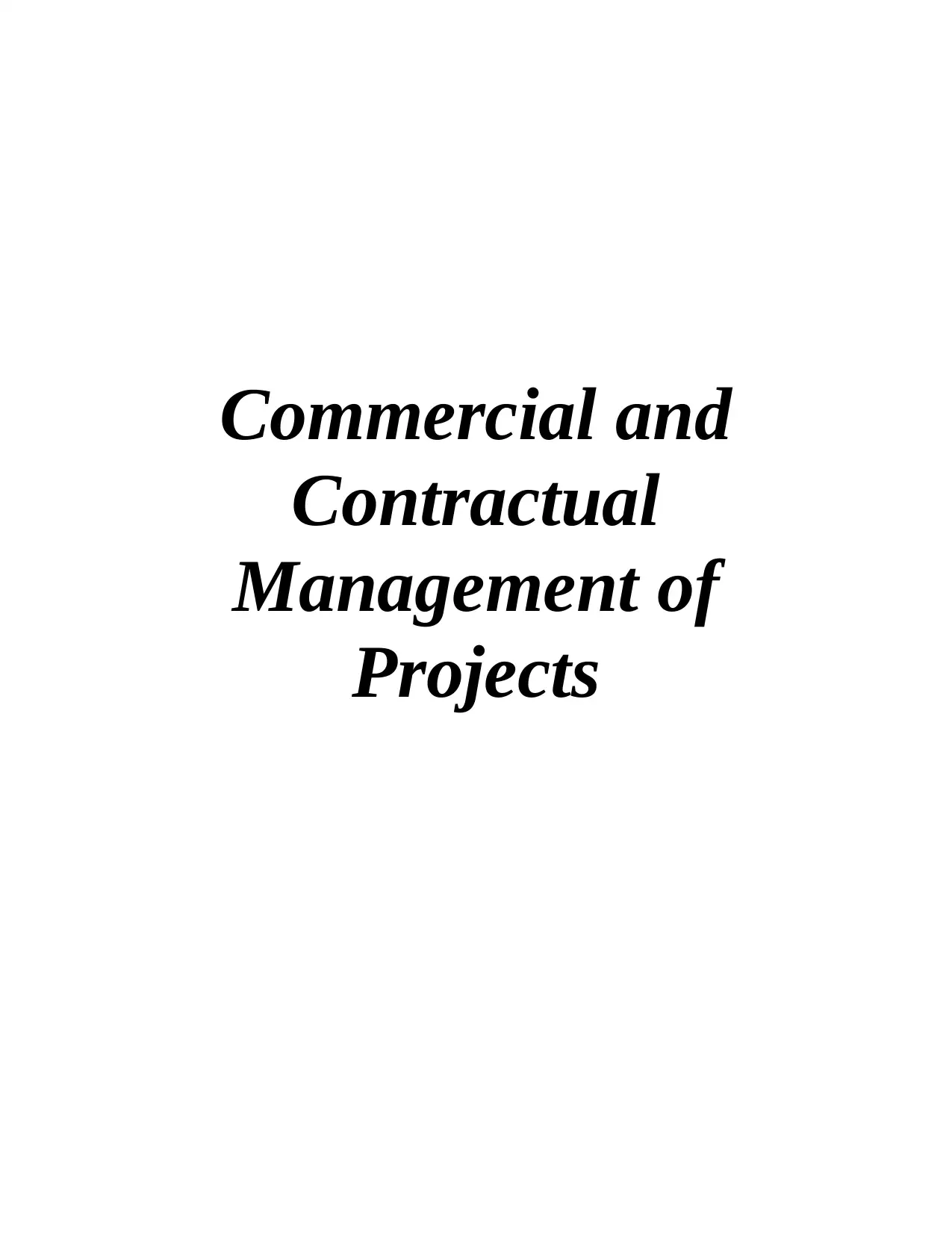
Commercial and
Contractual
Management of
Projects
Contractual
Management of
Projects
Paraphrase This Document
Need a fresh take? Get an instant paraphrase of this document with our AI Paraphraser
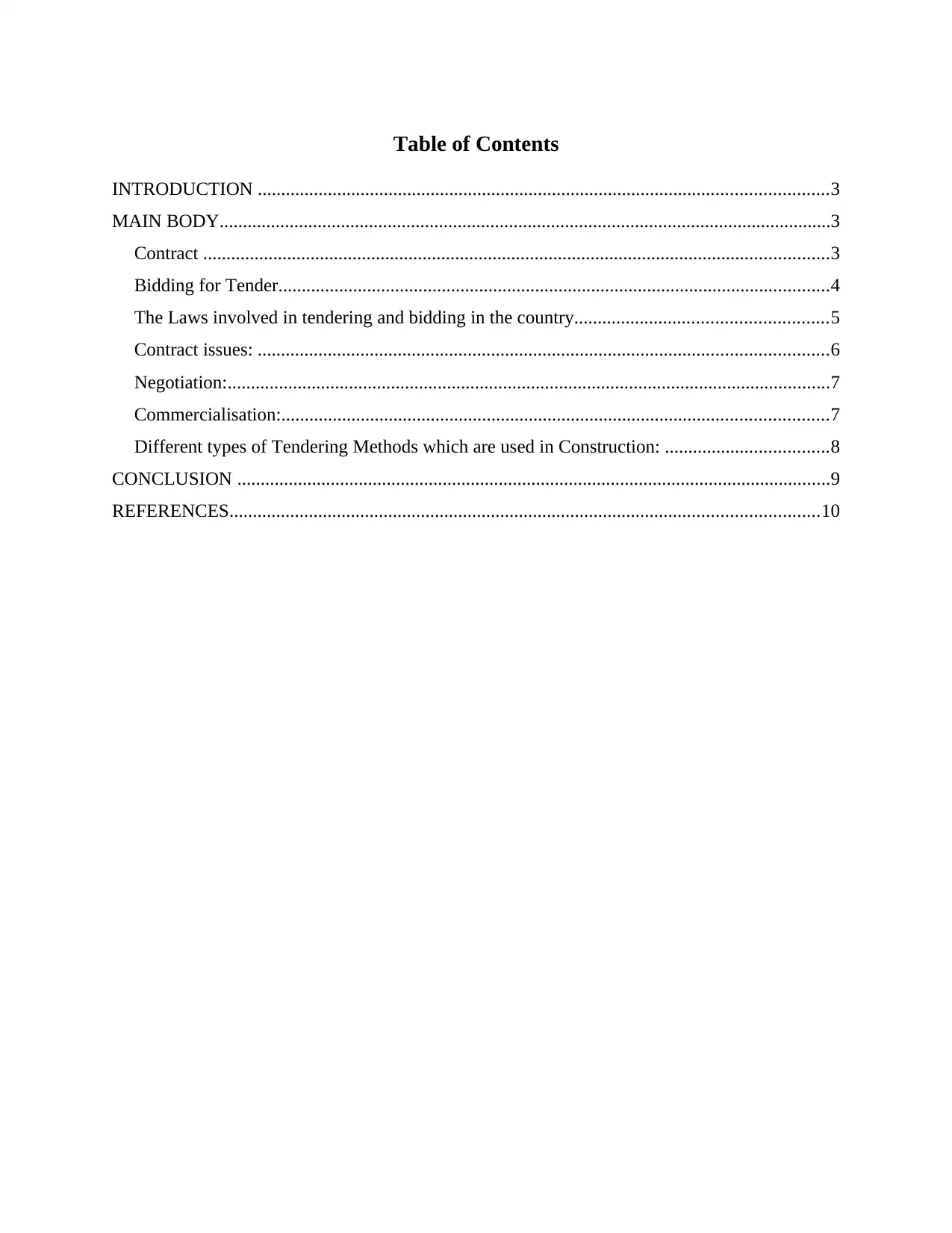
Table of Contents
INTRODUCTION ..........................................................................................................................3
MAIN BODY...................................................................................................................................3
Contract ......................................................................................................................................3
Bidding for Tender......................................................................................................................4
The Laws involved in tendering and bidding in the country......................................................5
Contract issues: ..........................................................................................................................6
Negotiation:.................................................................................................................................7
Commercialisation:.....................................................................................................................7
Different types of Tendering Methods which are used in Construction: ...................................8
CONCLUSION ...............................................................................................................................9
REFERENCES..............................................................................................................................10
INTRODUCTION ..........................................................................................................................3
MAIN BODY...................................................................................................................................3
Contract ......................................................................................................................................3
Bidding for Tender......................................................................................................................4
The Laws involved in tendering and bidding in the country......................................................5
Contract issues: ..........................................................................................................................6
Negotiation:.................................................................................................................................7
Commercialisation:.....................................................................................................................7
Different types of Tendering Methods which are used in Construction: ...................................8
CONCLUSION ...............................................................................................................................9
REFERENCES..............................................................................................................................10
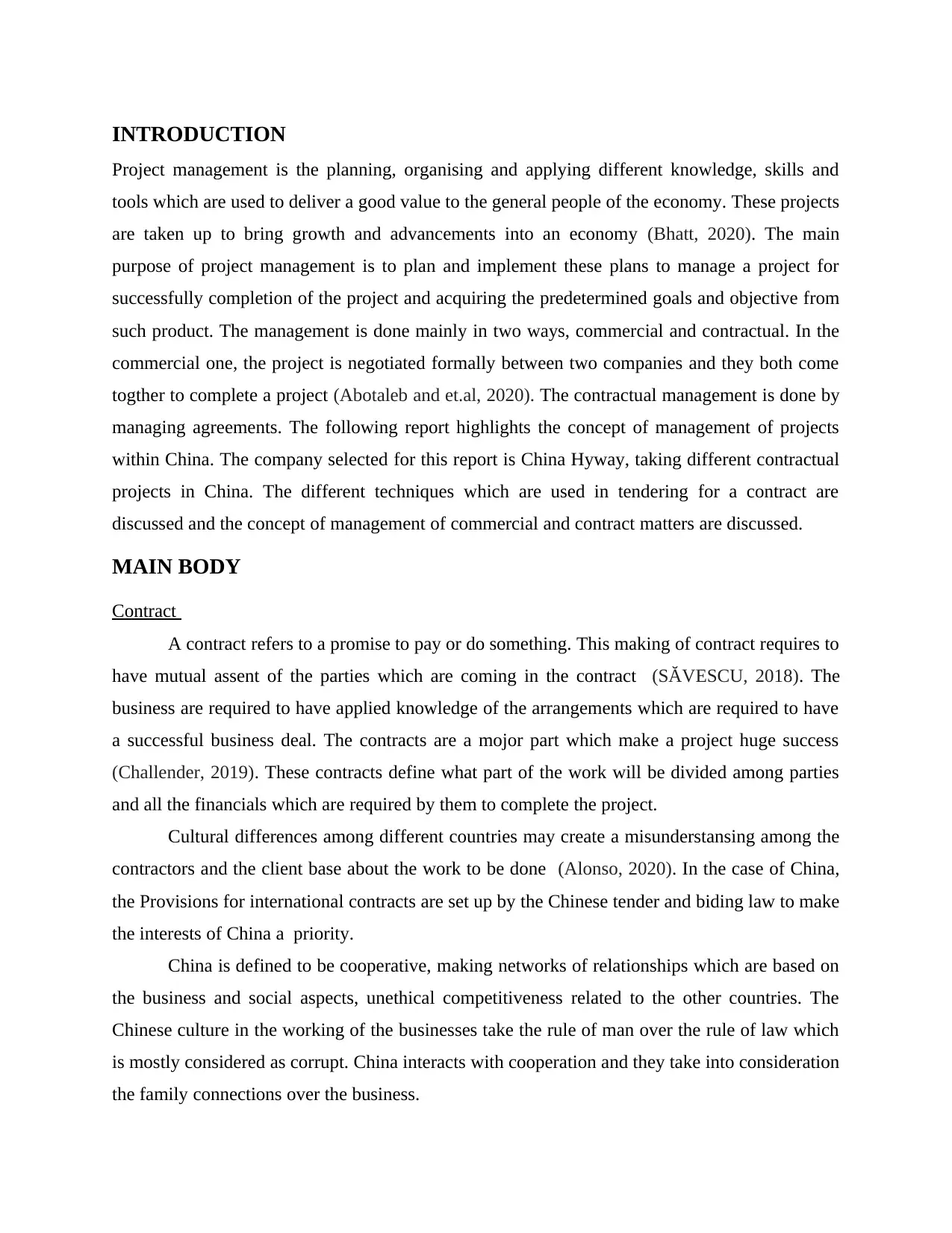
INTRODUCTION
Project management is the planning, organising and applying different knowledge, skills and
tools which are used to deliver a good value to the general people of the economy. These projects
are taken up to bring growth and advancements into an economy (Bhatt, 2020). The main
purpose of project management is to plan and implement these plans to manage a project for
successfully completion of the project and acquiring the predetermined goals and objective from
such product. The management is done mainly in two ways, commercial and contractual. In the
commercial one, the project is negotiated formally between two companies and they both come
togther to complete a project (Abotaleb and et.al, 2020). The contractual management is done by
managing agreements. The following report highlights the concept of management of projects
within China. The company selected for this report is China Hyway, taking different contractual
projects in China. The different techniques which are used in tendering for a contract are
discussed and the concept of management of commercial and contract matters are discussed.
MAIN BODY
Contract
A contract refers to a promise to pay or do something. This making of contract requires to
have mutual assent of the parties which are coming in the contract (SĂVESCU, 2018). The
business are required to have applied knowledge of the arrangements which are required to have
a successful business deal. The contracts are a mojor part which make a project huge success
(Challender, 2019). These contracts define what part of the work will be divided among parties
and all the financials which are required by them to complete the project.
Cultural differences among different countries may create a misunderstansing among the
contractors and the client base about the work to be done (Alonso, 2020). In the case of China,
the Provisions for international contracts are set up by the Chinese tender and biding law to make
the interests of China a priority.
China is defined to be cooperative, making networks of relationships which are based on
the business and social aspects, unethical competitiveness related to the other countries. The
Chinese culture in the working of the businesses take the rule of man over the rule of law which
is mostly considered as corrupt. China interacts with cooperation and they take into consideration
the family connections over the business.
Project management is the planning, organising and applying different knowledge, skills and
tools which are used to deliver a good value to the general people of the economy. These projects
are taken up to bring growth and advancements into an economy (Bhatt, 2020). The main
purpose of project management is to plan and implement these plans to manage a project for
successfully completion of the project and acquiring the predetermined goals and objective from
such product. The management is done mainly in two ways, commercial and contractual. In the
commercial one, the project is negotiated formally between two companies and they both come
togther to complete a project (Abotaleb and et.al, 2020). The contractual management is done by
managing agreements. The following report highlights the concept of management of projects
within China. The company selected for this report is China Hyway, taking different contractual
projects in China. The different techniques which are used in tendering for a contract are
discussed and the concept of management of commercial and contract matters are discussed.
MAIN BODY
Contract
A contract refers to a promise to pay or do something. This making of contract requires to
have mutual assent of the parties which are coming in the contract (SĂVESCU, 2018). The
business are required to have applied knowledge of the arrangements which are required to have
a successful business deal. The contracts are a mojor part which make a project huge success
(Challender, 2019). These contracts define what part of the work will be divided among parties
and all the financials which are required by them to complete the project.
Cultural differences among different countries may create a misunderstansing among the
contractors and the client base about the work to be done (Alonso, 2020). In the case of China,
the Provisions for international contracts are set up by the Chinese tender and biding law to make
the interests of China a priority.
China is defined to be cooperative, making networks of relationships which are based on
the business and social aspects, unethical competitiveness related to the other countries. The
Chinese culture in the working of the businesses take the rule of man over the rule of law which
is mostly considered as corrupt. China interacts with cooperation and they take into consideration
the family connections over the business.
⊘ This is a preview!⊘
Do you want full access?
Subscribe today to unlock all pages.

Trusted by 1+ million students worldwide
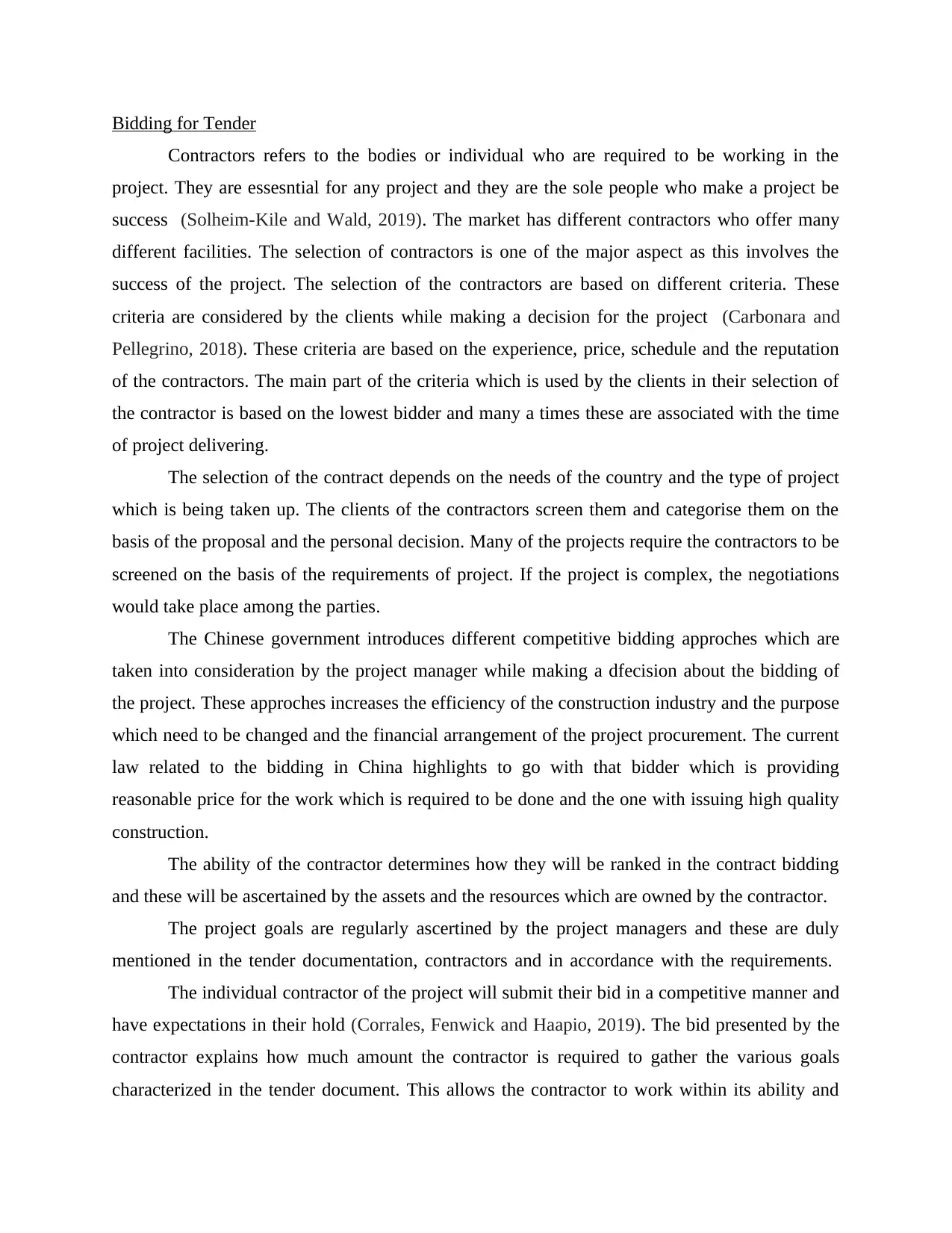
Bidding for Tender
Contractors refers to the bodies or individual who are required to be working in the
project. They are essesntial for any project and they are the sole people who make a project be
success (Solheim-Kile and Wald, 2019). The market has different contractors who offer many
different facilities. The selection of contractors is one of the major aspect as this involves the
success of the project. The selection of the contractors are based on different criteria. These
criteria are considered by the clients while making a decision for the project (Carbonara and
Pellegrino, 2018). These criteria are based on the experience, price, schedule and the reputation
of the contractors. The main part of the criteria which is used by the clients in their selection of
the contractor is based on the lowest bidder and many a times these are associated with the time
of project delivering.
The selection of the contract depends on the needs of the country and the type of project
which is being taken up. The clients of the contractors screen them and categorise them on the
basis of the proposal and the personal decision. Many of the projects require the contractors to be
screened on the basis of the requirements of project. If the project is complex, the negotiations
would take place among the parties.
The Chinese government introduces different competitive bidding approches which are
taken into consideration by the project manager while making a dfecision about the bidding of
the project. These approches increases the efficiency of the construction industry and the purpose
which need to be changed and the financial arrangement of the project procurement. The current
law related to the bidding in China highlights to go with that bidder which is providing
reasonable price for the work which is required to be done and the one with issuing high quality
construction.
The ability of the contractor determines how they will be ranked in the contract bidding
and these will be ascertained by the assets and the resources which are owned by the contractor.
The project goals are regularly ascertined by the project managers and these are duly
mentioned in the tender documentation, contractors and in accordance with the requirements.
The individual contractor of the project will submit their bid in a competitive manner and
have expectations in their hold (Corrales, Fenwick and Haapio, 2019). The bid presented by the
contractor explains how much amount the contractor is required to gather the various goals
characterized in the tender document. This allows the contractor to work within its ability and
Contractors refers to the bodies or individual who are required to be working in the
project. They are essesntial for any project and they are the sole people who make a project be
success (Solheim-Kile and Wald, 2019). The market has different contractors who offer many
different facilities. The selection of contractors is one of the major aspect as this involves the
success of the project. The selection of the contractors are based on different criteria. These
criteria are considered by the clients while making a decision for the project (Carbonara and
Pellegrino, 2018). These criteria are based on the experience, price, schedule and the reputation
of the contractors. The main part of the criteria which is used by the clients in their selection of
the contractor is based on the lowest bidder and many a times these are associated with the time
of project delivering.
The selection of the contract depends on the needs of the country and the type of project
which is being taken up. The clients of the contractors screen them and categorise them on the
basis of the proposal and the personal decision. Many of the projects require the contractors to be
screened on the basis of the requirements of project. If the project is complex, the negotiations
would take place among the parties.
The Chinese government introduces different competitive bidding approches which are
taken into consideration by the project manager while making a dfecision about the bidding of
the project. These approches increases the efficiency of the construction industry and the purpose
which need to be changed and the financial arrangement of the project procurement. The current
law related to the bidding in China highlights to go with that bidder which is providing
reasonable price for the work which is required to be done and the one with issuing high quality
construction.
The ability of the contractor determines how they will be ranked in the contract bidding
and these will be ascertained by the assets and the resources which are owned by the contractor.
The project goals are regularly ascertined by the project managers and these are duly
mentioned in the tender documentation, contractors and in accordance with the requirements.
The individual contractor of the project will submit their bid in a competitive manner and
have expectations in their hold (Corrales, Fenwick and Haapio, 2019). The bid presented by the
contractor explains how much amount the contractor is required to gather the various goals
characterized in the tender document. This allows the contractor to work within its ability and
Paraphrase This Document
Need a fresh take? Get an instant paraphrase of this document with our AI Paraphraser
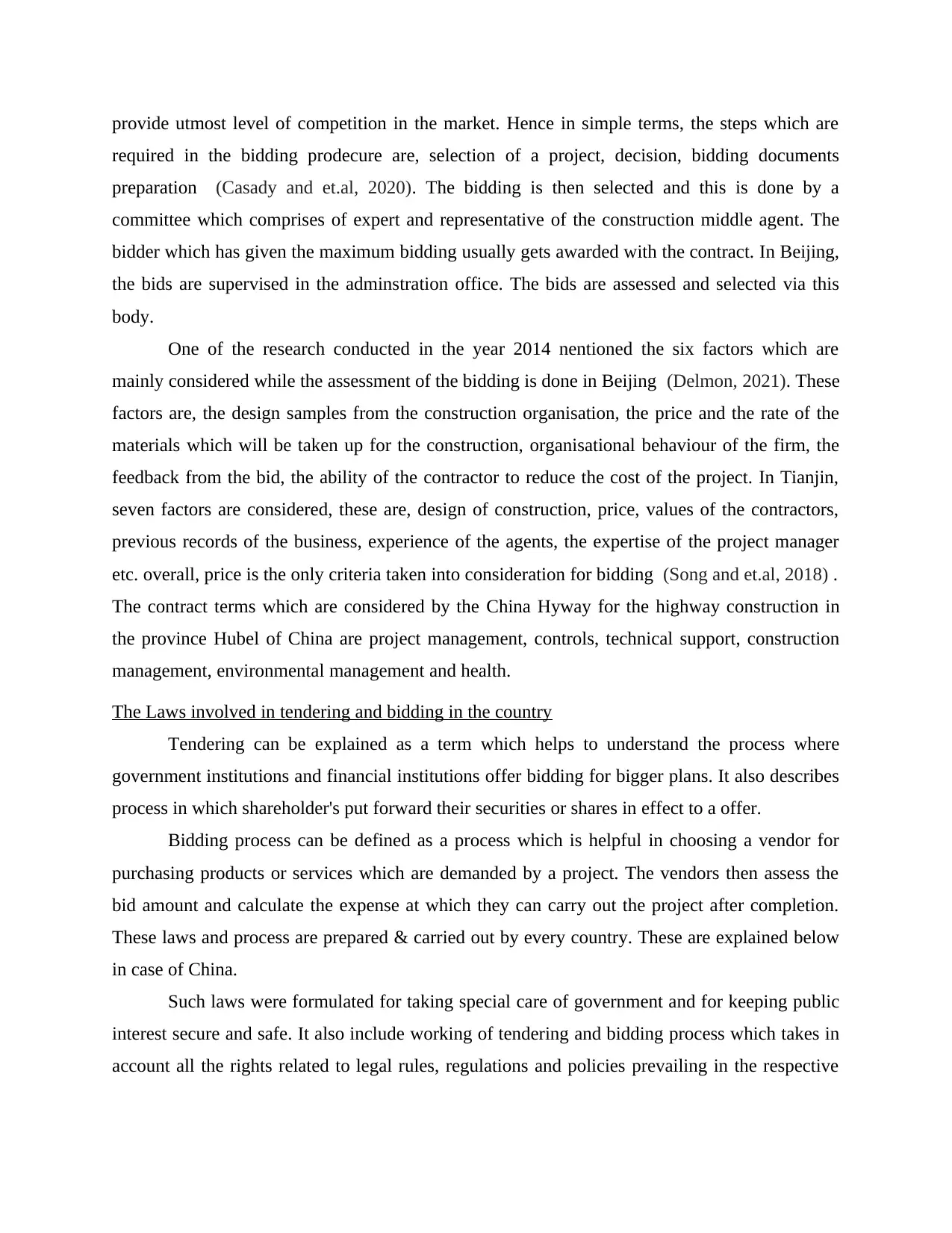
provide utmost level of competition in the market. Hence in simple terms, the steps which are
required in the bidding prodecure are, selection of a project, decision, bidding documents
preparation (Casady and et.al, 2020). The bidding is then selected and this is done by a
committee which comprises of expert and representative of the construction middle agent. The
bidder which has given the maximum bidding usually gets awarded with the contract. In Beijing,
the bids are supervised in the adminstration office. The bids are assessed and selected via this
body.
One of the research conducted in the year 2014 nentioned the six factors which are
mainly considered while the assessment of the bidding is done in Beijing (Delmon, 2021). These
factors are, the design samples from the construction organisation, the price and the rate of the
materials which will be taken up for the construction, organisational behaviour of the firm, the
feedback from the bid, the ability of the contractor to reduce the cost of the project. In Tianjin,
seven factors are considered, these are, design of construction, price, values of the contractors,
previous records of the business, experience of the agents, the expertise of the project manager
etc. overall, price is the only criteria taken into consideration for bidding (Song and et.al, 2018) .
The contract terms which are considered by the China Hyway for the highway construction in
the province Hubel of China are project management, controls, technical support, construction
management, environmental management and health.
The Laws involved in tendering and bidding in the country
Tendering can be explained as a term which helps to understand the process where
government institutions and financial institutions offer bidding for bigger plans. It also describes
process in which shareholder's put forward their securities or shares in effect to a offer.
Bidding process can be defined as a process which is helpful in choosing a vendor for
purchasing products or services which are demanded by a project. The vendors then assess the
bid amount and calculate the expense at which they can carry out the project after completion.
These laws and process are prepared & carried out by every country. These are explained below
in case of China.
Such laws were formulated for taking special care of government and for keeping public
interest secure and safe. It also include working of tendering and bidding process which takes in
account all the rights related to legal rules, regulations and policies prevailing in the respective
required in the bidding prodecure are, selection of a project, decision, bidding documents
preparation (Casady and et.al, 2020). The bidding is then selected and this is done by a
committee which comprises of expert and representative of the construction middle agent. The
bidder which has given the maximum bidding usually gets awarded with the contract. In Beijing,
the bids are supervised in the adminstration office. The bids are assessed and selected via this
body.
One of the research conducted in the year 2014 nentioned the six factors which are
mainly considered while the assessment of the bidding is done in Beijing (Delmon, 2021). These
factors are, the design samples from the construction organisation, the price and the rate of the
materials which will be taken up for the construction, organisational behaviour of the firm, the
feedback from the bid, the ability of the contractor to reduce the cost of the project. In Tianjin,
seven factors are considered, these are, design of construction, price, values of the contractors,
previous records of the business, experience of the agents, the expertise of the project manager
etc. overall, price is the only criteria taken into consideration for bidding (Song and et.al, 2018) .
The contract terms which are considered by the China Hyway for the highway construction in
the province Hubel of China are project management, controls, technical support, construction
management, environmental management and health.
The Laws involved in tendering and bidding in the country
Tendering can be explained as a term which helps to understand the process where
government institutions and financial institutions offer bidding for bigger plans. It also describes
process in which shareholder's put forward their securities or shares in effect to a offer.
Bidding process can be defined as a process which is helpful in choosing a vendor for
purchasing products or services which are demanded by a project. The vendors then assess the
bid amount and calculate the expense at which they can carry out the project after completion.
These laws and process are prepared & carried out by every country. These are explained below
in case of China.
Such laws were formulated for taking special care of government and for keeping public
interest secure and safe. It also include working of tendering and bidding process which takes in
account all the rights related to legal rules, regulations and policies prevailing in the respective
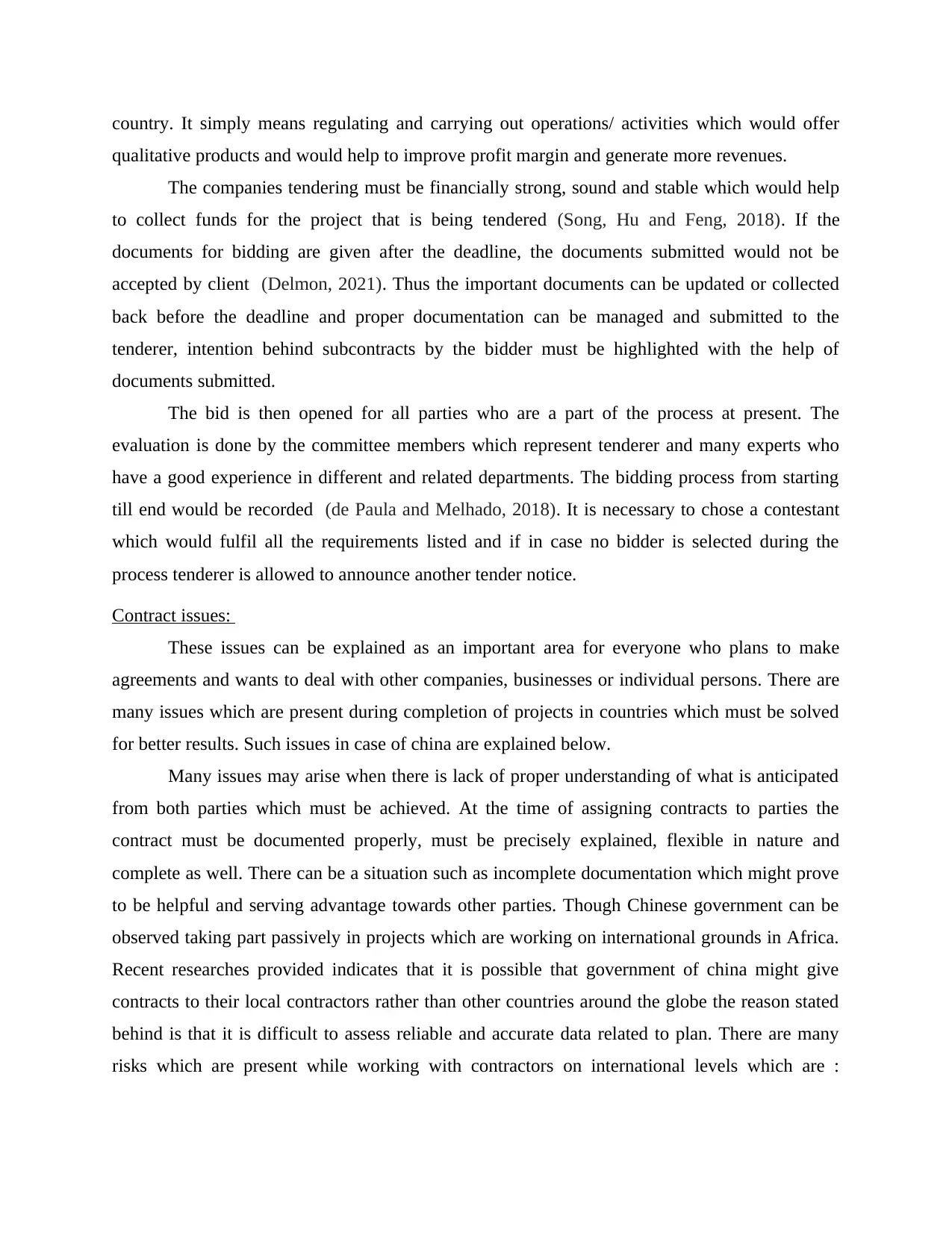
country. It simply means regulating and carrying out operations/ activities which would offer
qualitative products and would help to improve profit margin and generate more revenues.
The companies tendering must be financially strong, sound and stable which would help
to collect funds for the project that is being tendered (Song, Hu and Feng, 2018). If the
documents for bidding are given after the deadline, the documents submitted would not be
accepted by client (Delmon, 2021). Thus the important documents can be updated or collected
back before the deadline and proper documentation can be managed and submitted to the
tenderer, intention behind subcontracts by the bidder must be highlighted with the help of
documents submitted.
The bid is then opened for all parties who are a part of the process at present. The
evaluation is done by the committee members which represent tenderer and many experts who
have a good experience in different and related departments. The bidding process from starting
till end would be recorded (de Paula and Melhado, 2018). It is necessary to chose a contestant
which would fulfil all the requirements listed and if in case no bidder is selected during the
process tenderer is allowed to announce another tender notice.
Contract issues:
These issues can be explained as an important area for everyone who plans to make
agreements and wants to deal with other companies, businesses or individual persons. There are
many issues which are present during completion of projects in countries which must be solved
for better results. Such issues in case of china are explained below.
Many issues may arise when there is lack of proper understanding of what is anticipated
from both parties which must be achieved. At the time of assigning contracts to parties the
contract must be documented properly, must be precisely explained, flexible in nature and
complete as well. There can be a situation such as incomplete documentation which might prove
to be helpful and serving advantage towards other parties. Though Chinese government can be
observed taking part passively in projects which are working on international grounds in Africa.
Recent researches provided indicates that it is possible that government of china might give
contracts to their local contractors rather than other countries around the globe the reason stated
behind is that it is difficult to assess reliable and accurate data related to plan. There are many
risks which are present while working with contractors on international levels which are :
qualitative products and would help to improve profit margin and generate more revenues.
The companies tendering must be financially strong, sound and stable which would help
to collect funds for the project that is being tendered (Song, Hu and Feng, 2018). If the
documents for bidding are given after the deadline, the documents submitted would not be
accepted by client (Delmon, 2021). Thus the important documents can be updated or collected
back before the deadline and proper documentation can be managed and submitted to the
tenderer, intention behind subcontracts by the bidder must be highlighted with the help of
documents submitted.
The bid is then opened for all parties who are a part of the process at present. The
evaluation is done by the committee members which represent tenderer and many experts who
have a good experience in different and related departments. The bidding process from starting
till end would be recorded (de Paula and Melhado, 2018). It is necessary to chose a contestant
which would fulfil all the requirements listed and if in case no bidder is selected during the
process tenderer is allowed to announce another tender notice.
Contract issues:
These issues can be explained as an important area for everyone who plans to make
agreements and wants to deal with other companies, businesses or individual persons. There are
many issues which are present during completion of projects in countries which must be solved
for better results. Such issues in case of china are explained below.
Many issues may arise when there is lack of proper understanding of what is anticipated
from both parties which must be achieved. At the time of assigning contracts to parties the
contract must be documented properly, must be precisely explained, flexible in nature and
complete as well. There can be a situation such as incomplete documentation which might prove
to be helpful and serving advantage towards other parties. Though Chinese government can be
observed taking part passively in projects which are working on international grounds in Africa.
Recent researches provided indicates that it is possible that government of china might give
contracts to their local contractors rather than other countries around the globe the reason stated
behind is that it is difficult to assess reliable and accurate data related to plan. There are many
risks which are present while working with contractors on international levels which are :
⊘ This is a preview!⊘
Do you want full access?
Subscribe today to unlock all pages.

Trusted by 1+ million students worldwide
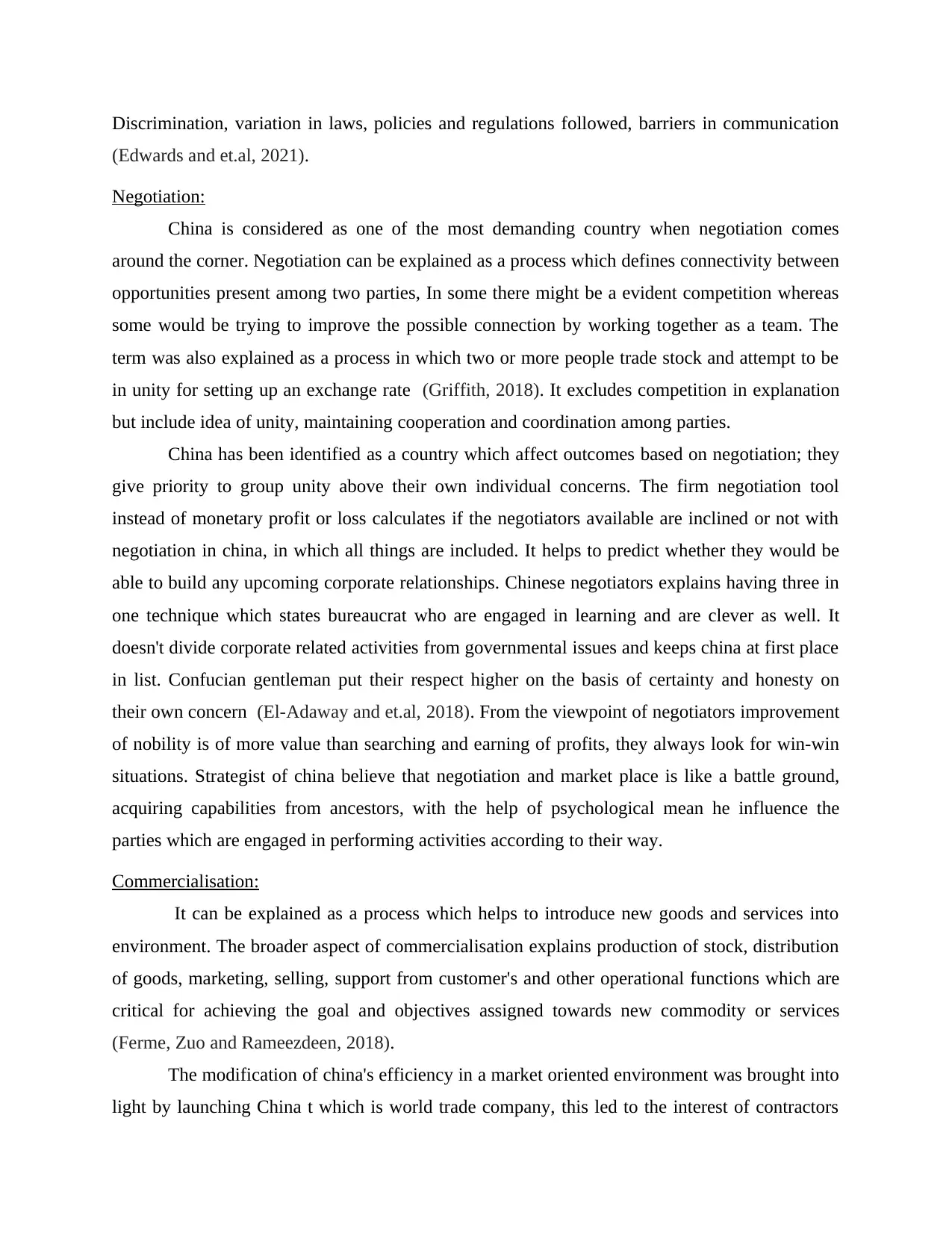
Discrimination, variation in laws, policies and regulations followed, barriers in communication
(Edwards and et.al, 2021).
Negotiation:
China is considered as one of the most demanding country when negotiation comes
around the corner. Negotiation can be explained as a process which defines connectivity between
opportunities present among two parties, In some there might be a evident competition whereas
some would be trying to improve the possible connection by working together as a team. The
term was also explained as a process in which two or more people trade stock and attempt to be
in unity for setting up an exchange rate (Griffith, 2018). It excludes competition in explanation
but include idea of unity, maintaining cooperation and coordination among parties.
China has been identified as a country which affect outcomes based on negotiation; they
give priority to group unity above their own individual concerns. The firm negotiation tool
instead of monetary profit or loss calculates if the negotiators available are inclined or not with
negotiation in china, in which all things are included. It helps to predict whether they would be
able to build any upcoming corporate relationships. Chinese negotiators explains having three in
one technique which states bureaucrat who are engaged in learning and are clever as well. It
doesn't divide corporate related activities from governmental issues and keeps china at first place
in list. Confucian gentleman put their respect higher on the basis of certainty and honesty on
their own concern (El-Adaway and et.al, 2018). From the viewpoint of negotiators improvement
of nobility is of more value than searching and earning of profits, they always look for win-win
situations. Strategist of china believe that negotiation and market place is like a battle ground,
acquiring capabilities from ancestors, with the help of psychological mean he influence the
parties which are engaged in performing activities according to their way.
Commercialisation:
It can be explained as a process which helps to introduce new goods and services into
environment. The broader aspect of commercialisation explains production of stock, distribution
of goods, marketing, selling, support from customer's and other operational functions which are
critical for achieving the goal and objectives assigned towards new commodity or services
(Ferme, Zuo and Rameezdeen, 2018).
The modification of china's efficiency in a market oriented environment was brought into
light by launching China t which is world trade company, this led to the interest of contractors
(Edwards and et.al, 2021).
Negotiation:
China is considered as one of the most demanding country when negotiation comes
around the corner. Negotiation can be explained as a process which defines connectivity between
opportunities present among two parties, In some there might be a evident competition whereas
some would be trying to improve the possible connection by working together as a team. The
term was also explained as a process in which two or more people trade stock and attempt to be
in unity for setting up an exchange rate (Griffith, 2018). It excludes competition in explanation
but include idea of unity, maintaining cooperation and coordination among parties.
China has been identified as a country which affect outcomes based on negotiation; they
give priority to group unity above their own individual concerns. The firm negotiation tool
instead of monetary profit or loss calculates if the negotiators available are inclined or not with
negotiation in china, in which all things are included. It helps to predict whether they would be
able to build any upcoming corporate relationships. Chinese negotiators explains having three in
one technique which states bureaucrat who are engaged in learning and are clever as well. It
doesn't divide corporate related activities from governmental issues and keeps china at first place
in list. Confucian gentleman put their respect higher on the basis of certainty and honesty on
their own concern (El-Adaway and et.al, 2018). From the viewpoint of negotiators improvement
of nobility is of more value than searching and earning of profits, they always look for win-win
situations. Strategist of china believe that negotiation and market place is like a battle ground,
acquiring capabilities from ancestors, with the help of psychological mean he influence the
parties which are engaged in performing activities according to their way.
Commercialisation:
It can be explained as a process which helps to introduce new goods and services into
environment. The broader aspect of commercialisation explains production of stock, distribution
of goods, marketing, selling, support from customer's and other operational functions which are
critical for achieving the goal and objectives assigned towards new commodity or services
(Ferme, Zuo and Rameezdeen, 2018).
The modification of china's efficiency in a market oriented environment was brought into
light by launching China t which is world trade company, this led to the interest of contractors
Paraphrase This Document
Need a fresh take? Get an instant paraphrase of this document with our AI Paraphraser
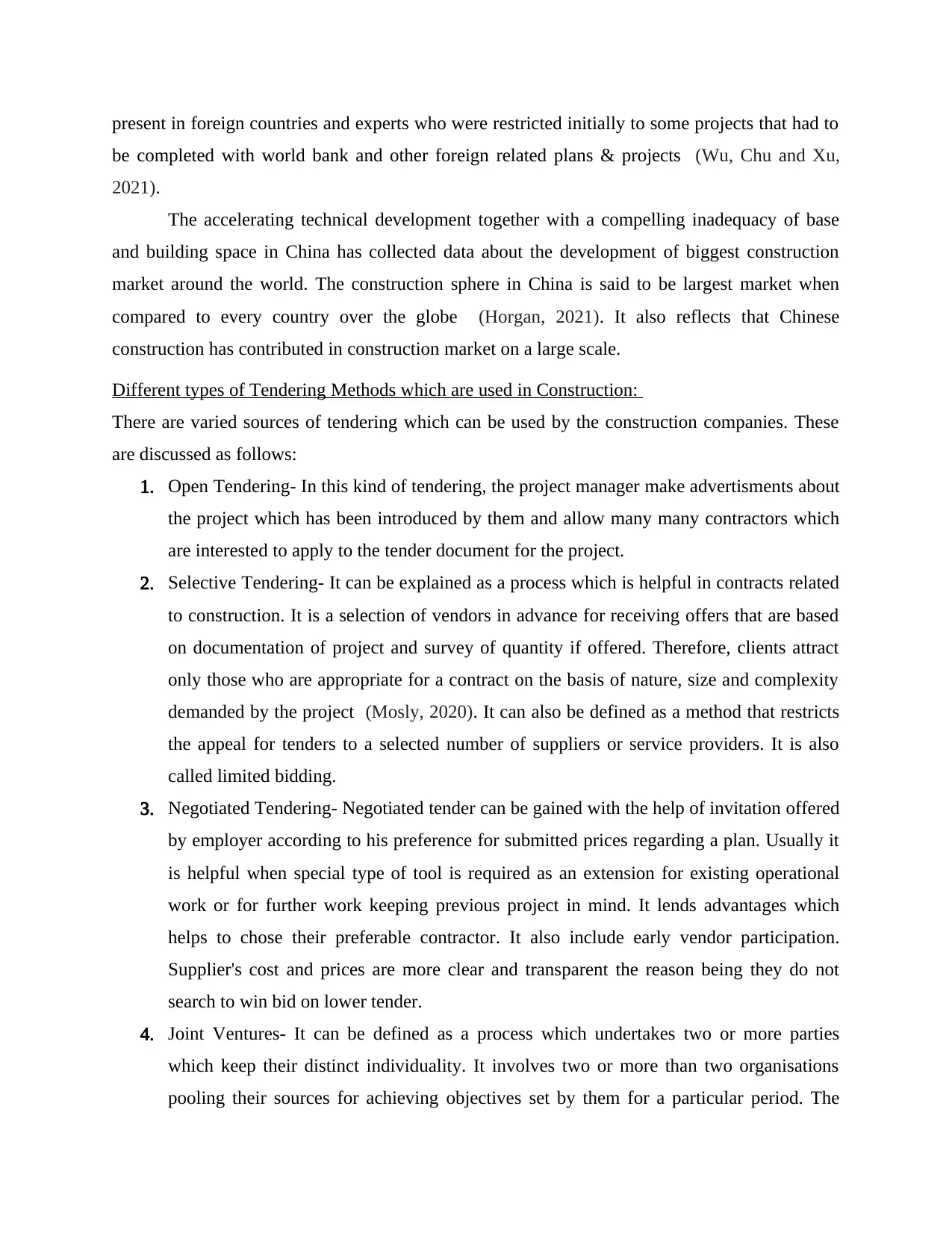
present in foreign countries and experts who were restricted initially to some projects that had to
be completed with world bank and other foreign related plans & projects (Wu, Chu and Xu,
2021).
The accelerating technical development together with a compelling inadequacy of base
and building space in China has collected data about the development of biggest construction
market around the world. The construction sphere in China is said to be largest market when
compared to every country over the globe (Horgan, 2021). It also reflects that Chinese
construction has contributed in construction market on a large scale.
Different types of Tendering Methods which are used in Construction:
There are varied sources of tendering which can be used by the construction companies. These
are discussed as follows:
1. Open Tendering- In this kind of tendering, the project manager make advertisments about
the project which has been introduced by them and allow many many contractors which
are interested to apply to the tender document for the project.
2. Selective Tendering- It can be explained as a process which is helpful in contracts related
to construction. It is a selection of vendors in advance for receiving offers that are based
on documentation of project and survey of quantity if offered. Therefore, clients attract
only those who are appropriate for a contract on the basis of nature, size and complexity
demanded by the project (Mosly, 2020). It can also be defined as a method that restricts
the appeal for tenders to a selected number of suppliers or service providers. It is also
called limited bidding.
3. Negotiated Tendering- Negotiated tender can be gained with the help of invitation offered
by employer according to his preference for submitted prices regarding a plan. Usually it
is helpful when special type of tool is required as an extension for existing operational
work or for further work keeping previous project in mind. It lends advantages which
helps to chose their preferable contractor. It also include early vendor participation.
Supplier's cost and prices are more clear and transparent the reason being they do not
search to win bid on lower tender.
4. Joint Ventures- It can be defined as a process which undertakes two or more parties
which keep their distinct individuality. It involves two or more than two organisations
pooling their sources for achieving objectives set by them for a particular period. The
be completed with world bank and other foreign related plans & projects (Wu, Chu and Xu,
2021).
The accelerating technical development together with a compelling inadequacy of base
and building space in China has collected data about the development of biggest construction
market around the world. The construction sphere in China is said to be largest market when
compared to every country over the globe (Horgan, 2021). It also reflects that Chinese
construction has contributed in construction market on a large scale.
Different types of Tendering Methods which are used in Construction:
There are varied sources of tendering which can be used by the construction companies. These
are discussed as follows:
1. Open Tendering- In this kind of tendering, the project manager make advertisments about
the project which has been introduced by them and allow many many contractors which
are interested to apply to the tender document for the project.
2. Selective Tendering- It can be explained as a process which is helpful in contracts related
to construction. It is a selection of vendors in advance for receiving offers that are based
on documentation of project and survey of quantity if offered. Therefore, clients attract
only those who are appropriate for a contract on the basis of nature, size and complexity
demanded by the project (Mosly, 2020). It can also be defined as a method that restricts
the appeal for tenders to a selected number of suppliers or service providers. It is also
called limited bidding.
3. Negotiated Tendering- Negotiated tender can be gained with the help of invitation offered
by employer according to his preference for submitted prices regarding a plan. Usually it
is helpful when special type of tool is required as an extension for existing operational
work or for further work keeping previous project in mind. It lends advantages which
helps to chose their preferable contractor. It also include early vendor participation.
Supplier's cost and prices are more clear and transparent the reason being they do not
search to win bid on lower tender.
4. Joint Ventures- It can be defined as a process which undertakes two or more parties
which keep their distinct individuality. It involves two or more than two organisations
pooling their sources for achieving objectives set by them for a particular period. The
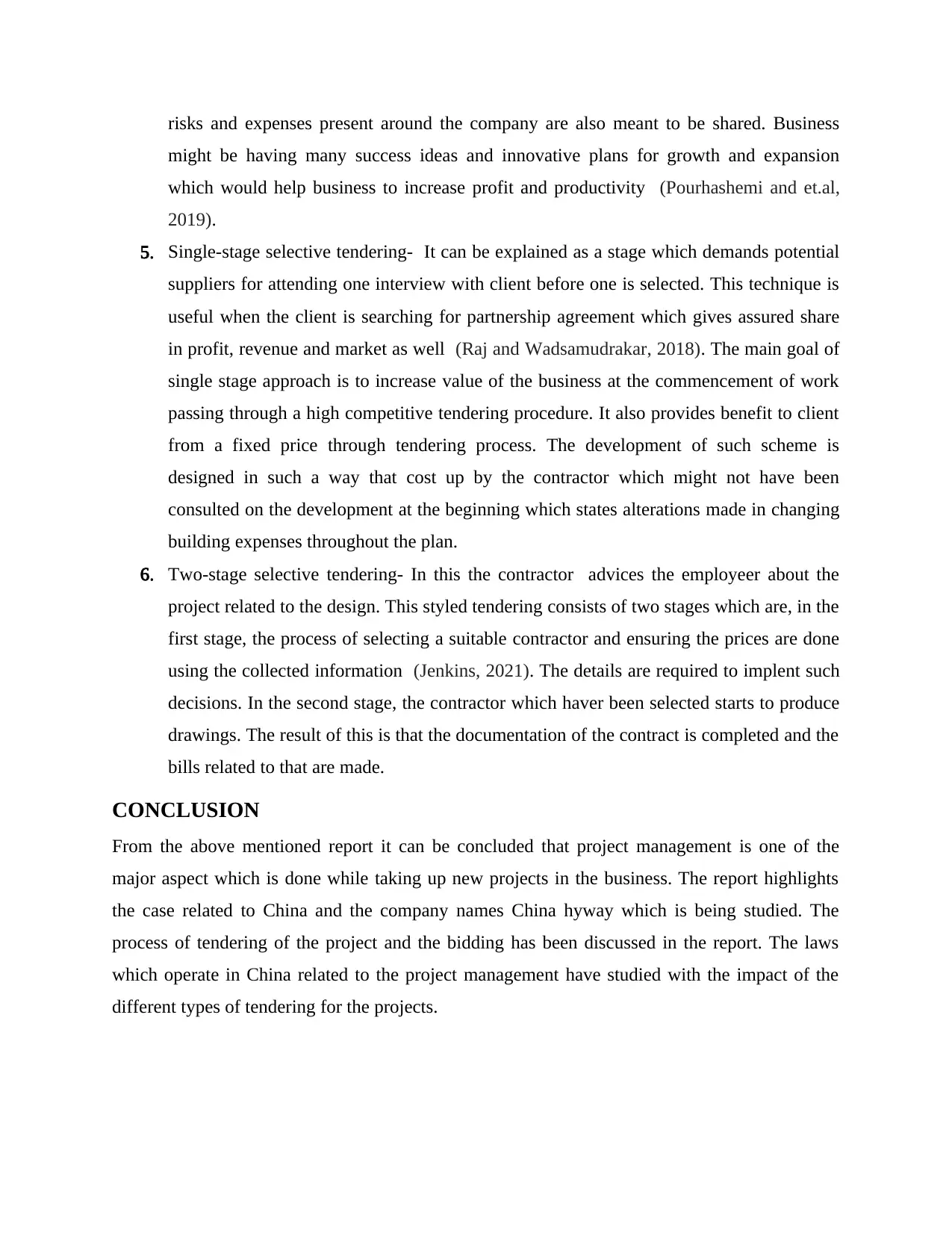
risks and expenses present around the company are also meant to be shared. Business
might be having many success ideas and innovative plans for growth and expansion
which would help business to increase profit and productivity (Pourhashemi and et.al,
2019).
5. Single-stage selective tendering- It can be explained as a stage which demands potential
suppliers for attending one interview with client before one is selected. This technique is
useful when the client is searching for partnership agreement which gives assured share
in profit, revenue and market as well (Raj and Wadsamudrakar, 2018). The main goal of
single stage approach is to increase value of the business at the commencement of work
passing through a high competitive tendering procedure. It also provides benefit to client
from a fixed price through tendering process. The development of such scheme is
designed in such a way that cost up by the contractor which might not have been
consulted on the development at the beginning which states alterations made in changing
building expenses throughout the plan.
6. Two-stage selective tendering- In this the contractor advices the employeer about the
project related to the design. This styled tendering consists of two stages which are, in the
first stage, the process of selecting a suitable contractor and ensuring the prices are done
using the collected information (Jenkins, 2021). The details are required to implent such
decisions. In the second stage, the contractor which haver been selected starts to produce
drawings. The result of this is that the documentation of the contract is completed and the
bills related to that are made.
CONCLUSION
From the above mentioned report it can be concluded that project management is one of the
major aspect which is done while taking up new projects in the business. The report highlights
the case related to China and the company names China hyway which is being studied. The
process of tendering of the project and the bidding has been discussed in the report. The laws
which operate in China related to the project management have studied with the impact of the
different types of tendering for the projects.
might be having many success ideas and innovative plans for growth and expansion
which would help business to increase profit and productivity (Pourhashemi and et.al,
2019).
5. Single-stage selective tendering- It can be explained as a stage which demands potential
suppliers for attending one interview with client before one is selected. This technique is
useful when the client is searching for partnership agreement which gives assured share
in profit, revenue and market as well (Raj and Wadsamudrakar, 2018). The main goal of
single stage approach is to increase value of the business at the commencement of work
passing through a high competitive tendering procedure. It also provides benefit to client
from a fixed price through tendering process. The development of such scheme is
designed in such a way that cost up by the contractor which might not have been
consulted on the development at the beginning which states alterations made in changing
building expenses throughout the plan.
6. Two-stage selective tendering- In this the contractor advices the employeer about the
project related to the design. This styled tendering consists of two stages which are, in the
first stage, the process of selecting a suitable contractor and ensuring the prices are done
using the collected information (Jenkins, 2021). The details are required to implent such
decisions. In the second stage, the contractor which haver been selected starts to produce
drawings. The result of this is that the documentation of the contract is completed and the
bills related to that are made.
CONCLUSION
From the above mentioned report it can be concluded that project management is one of the
major aspect which is done while taking up new projects in the business. The report highlights
the case related to China and the company names China hyway which is being studied. The
process of tendering of the project and the bidding has been discussed in the report. The laws
which operate in China related to the project management have studied with the impact of the
different types of tendering for the projects.
⊘ This is a preview!⊘
Do you want full access?
Subscribe today to unlock all pages.

Trusted by 1+ million students worldwide
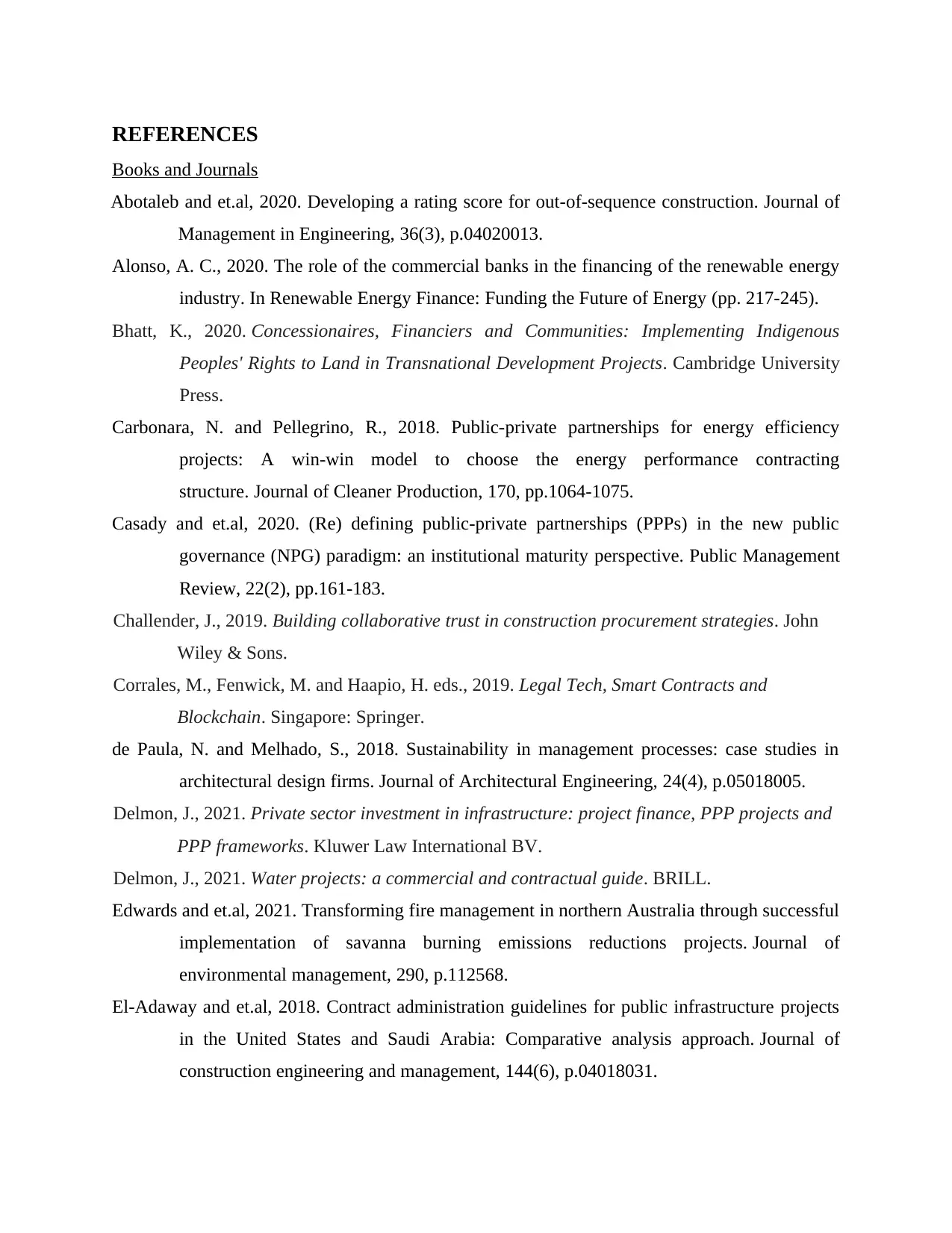
REFERENCES
Books and Journals
Abotaleb and et.al, 2020. Developing a rating score for out-of-sequence construction. Journal of
Management in Engineering, 36(3), p.04020013.
Alonso, A. C., 2020. The role of the commercial banks in the financing of the renewable energy
industry. In Renewable Energy Finance: Funding the Future of Energy (pp. 217-245).
Bhatt, K., 2020. Concessionaires, Financiers and Communities: Implementing Indigenous
Peoples' Rights to Land in Transnational Development Projects. Cambridge University
Press.
Carbonara, N. and Pellegrino, R., 2018. Public-private partnerships for energy efficiency
projects: A win-win model to choose the energy performance contracting
structure. Journal of Cleaner Production, 170, pp.1064-1075.
Casady and et.al, 2020. (Re) defining public-private partnerships (PPPs) in the new public
governance (NPG) paradigm: an institutional maturity perspective. Public Management
Review, 22(2), pp.161-183.
Challender, J., 2019. Building collaborative trust in construction procurement strategies. John
Wiley & Sons.
Corrales, M., Fenwick, M. and Haapio, H. eds., 2019. Legal Tech, Smart Contracts and
Blockchain. Singapore: Springer.
de Paula, N. and Melhado, S., 2018. Sustainability in management processes: case studies in
architectural design firms. Journal of Architectural Engineering, 24(4), p.05018005.
Delmon, J., 2021. Private sector investment in infrastructure: project finance, PPP projects and
PPP frameworks. Kluwer Law International BV.
Delmon, J., 2021. Water projects: a commercial and contractual guide. BRILL.
Edwards and et.al, 2021. Transforming fire management in northern Australia through successful
implementation of savanna burning emissions reductions projects. Journal of
environmental management, 290, p.112568.
El-Adaway and et.al, 2018. Contract administration guidelines for public infrastructure projects
in the United States and Saudi Arabia: Comparative analysis approach. Journal of
construction engineering and management, 144(6), p.04018031.
Books and Journals
Abotaleb and et.al, 2020. Developing a rating score for out-of-sequence construction. Journal of
Management in Engineering, 36(3), p.04020013.
Alonso, A. C., 2020. The role of the commercial banks in the financing of the renewable energy
industry. In Renewable Energy Finance: Funding the Future of Energy (pp. 217-245).
Bhatt, K., 2020. Concessionaires, Financiers and Communities: Implementing Indigenous
Peoples' Rights to Land in Transnational Development Projects. Cambridge University
Press.
Carbonara, N. and Pellegrino, R., 2018. Public-private partnerships for energy efficiency
projects: A win-win model to choose the energy performance contracting
structure. Journal of Cleaner Production, 170, pp.1064-1075.
Casady and et.al, 2020. (Re) defining public-private partnerships (PPPs) in the new public
governance (NPG) paradigm: an institutional maturity perspective. Public Management
Review, 22(2), pp.161-183.
Challender, J., 2019. Building collaborative trust in construction procurement strategies. John
Wiley & Sons.
Corrales, M., Fenwick, M. and Haapio, H. eds., 2019. Legal Tech, Smart Contracts and
Blockchain. Singapore: Springer.
de Paula, N. and Melhado, S., 2018. Sustainability in management processes: case studies in
architectural design firms. Journal of Architectural Engineering, 24(4), p.05018005.
Delmon, J., 2021. Private sector investment in infrastructure: project finance, PPP projects and
PPP frameworks. Kluwer Law International BV.
Delmon, J., 2021. Water projects: a commercial and contractual guide. BRILL.
Edwards and et.al, 2021. Transforming fire management in northern Australia through successful
implementation of savanna burning emissions reductions projects. Journal of
environmental management, 290, p.112568.
El-Adaway and et.al, 2018. Contract administration guidelines for public infrastructure projects
in the United States and Saudi Arabia: Comparative analysis approach. Journal of
construction engineering and management, 144(6), p.04018031.
Paraphrase This Document
Need a fresh take? Get an instant paraphrase of this document with our AI Paraphraser
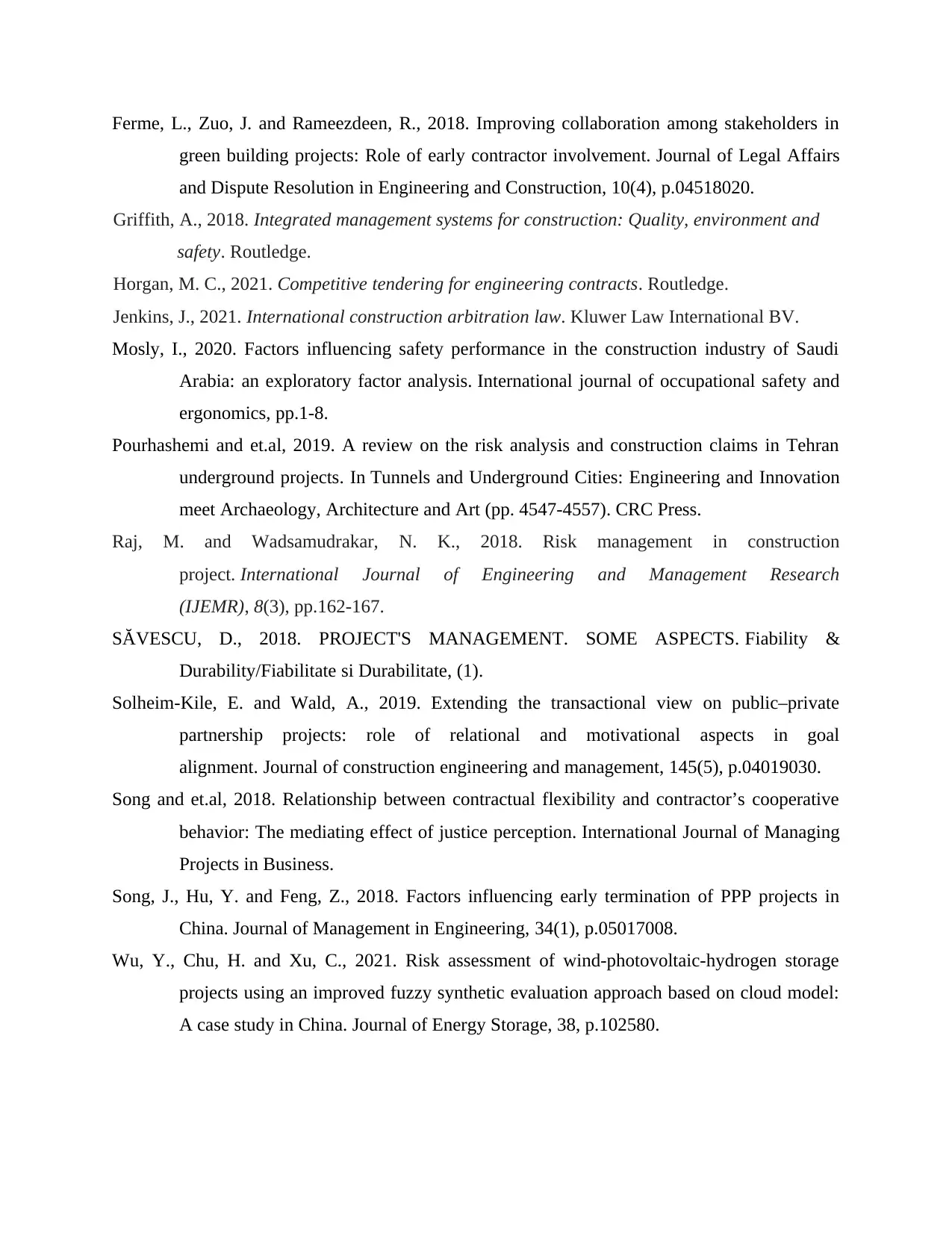
Ferme, L., Zuo, J. and Rameezdeen, R., 2018. Improving collaboration among stakeholders in
green building projects: Role of early contractor involvement. Journal of Legal Affairs
and Dispute Resolution in Engineering and Construction, 10(4), p.04518020.
Griffith, A., 2018. Integrated management systems for construction: Quality, environment and
safety. Routledge.
Horgan, M. C., 2021. Competitive tendering for engineering contracts. Routledge.
Jenkins, J., 2021. International construction arbitration law. Kluwer Law International BV.
Mosly, I., 2020. Factors influencing safety performance in the construction industry of Saudi
Arabia: an exploratory factor analysis. International journal of occupational safety and
ergonomics, pp.1-8.
Pourhashemi and et.al, 2019. A review on the risk analysis and construction claims in Tehran
underground projects. In Tunnels and Underground Cities: Engineering and Innovation
meet Archaeology, Architecture and Art (pp. 4547-4557). CRC Press.
Raj, M. and Wadsamudrakar, N. K., 2018. Risk management in construction
project. International Journal of Engineering and Management Research
(IJEMR), 8(3), pp.162-167.
SĂVESCU, D., 2018. PROJECT'S MANAGEMENT. SOME ASPECTS. Fiability &
Durability/Fiabilitate si Durabilitate, (1).
Solheim-Kile, E. and Wald, A., 2019. Extending the transactional view on public–private
partnership projects: role of relational and motivational aspects in goal
alignment. Journal of construction engineering and management, 145(5), p.04019030.
Song and et.al, 2018. Relationship between contractual flexibility and contractor’s cooperative
behavior: The mediating effect of justice perception. International Journal of Managing
Projects in Business.
Song, J., Hu, Y. and Feng, Z., 2018. Factors influencing early termination of PPP projects in
China. Journal of Management in Engineering, 34(1), p.05017008.
Wu, Y., Chu, H. and Xu, C., 2021. Risk assessment of wind-photovoltaic-hydrogen storage
projects using an improved fuzzy synthetic evaluation approach based on cloud model:
A case study in China. Journal of Energy Storage, 38, p.102580.
green building projects: Role of early contractor involvement. Journal of Legal Affairs
and Dispute Resolution in Engineering and Construction, 10(4), p.04518020.
Griffith, A., 2018. Integrated management systems for construction: Quality, environment and
safety. Routledge.
Horgan, M. C., 2021. Competitive tendering for engineering contracts. Routledge.
Jenkins, J., 2021. International construction arbitration law. Kluwer Law International BV.
Mosly, I., 2020. Factors influencing safety performance in the construction industry of Saudi
Arabia: an exploratory factor analysis. International journal of occupational safety and
ergonomics, pp.1-8.
Pourhashemi and et.al, 2019. A review on the risk analysis and construction claims in Tehran
underground projects. In Tunnels and Underground Cities: Engineering and Innovation
meet Archaeology, Architecture and Art (pp. 4547-4557). CRC Press.
Raj, M. and Wadsamudrakar, N. K., 2018. Risk management in construction
project. International Journal of Engineering and Management Research
(IJEMR), 8(3), pp.162-167.
SĂVESCU, D., 2018. PROJECT'S MANAGEMENT. SOME ASPECTS. Fiability &
Durability/Fiabilitate si Durabilitate, (1).
Solheim-Kile, E. and Wald, A., 2019. Extending the transactional view on public–private
partnership projects: role of relational and motivational aspects in goal
alignment. Journal of construction engineering and management, 145(5), p.04019030.
Song and et.al, 2018. Relationship between contractual flexibility and contractor’s cooperative
behavior: The mediating effect of justice perception. International Journal of Managing
Projects in Business.
Song, J., Hu, Y. and Feng, Z., 2018. Factors influencing early termination of PPP projects in
China. Journal of Management in Engineering, 34(1), p.05017008.
Wu, Y., Chu, H. and Xu, C., 2021. Risk assessment of wind-photovoltaic-hydrogen storage
projects using an improved fuzzy synthetic evaluation approach based on cloud model:
A case study in China. Journal of Energy Storage, 38, p.102580.
1 out of 11
Related Documents
Your All-in-One AI-Powered Toolkit for Academic Success.
+13062052269
info@desklib.com
Available 24*7 on WhatsApp / Email
![[object Object]](/_next/static/media/star-bottom.7253800d.svg)
Unlock your academic potential
Copyright © 2020–2025 A2Z Services. All Rights Reserved. Developed and managed by ZUCOL.




